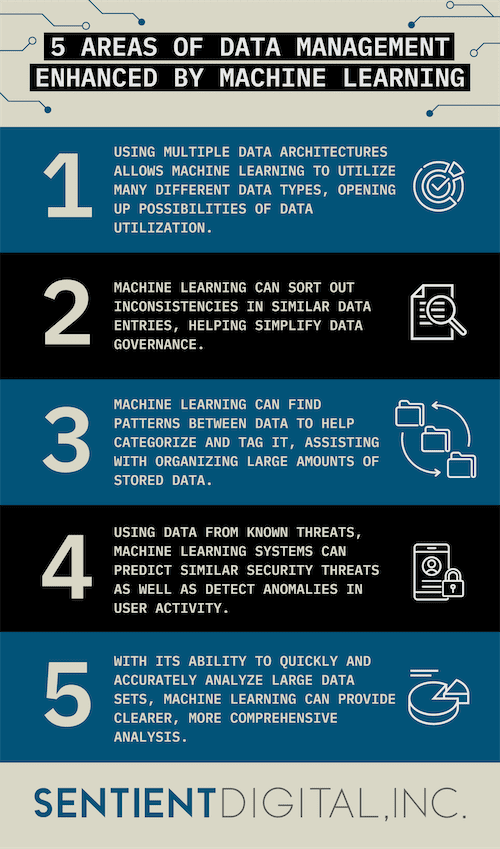Leveraging machine learning in data management allows businesses to better utilize the data they track. The scale of modern data management would not be possible without the application of machine learning, making it critical that organizations understand the synergies between them.
Companies are able to track and compile huge sums of data that then allow businesses to draw conclusions about the most important aspects of their products or services. Whether that’s learning exactly how many resources should be poured into which efforts or which teams are better working on different kinds of problems, good data management allows you to properly wring out every ounce of benefit from the data being tracked by your company.
The limitations of data management quickly become apparent as an organization gathers more data. That’s where machine learning comes in. Keep reading to gain a better understanding of the various aspects of machine learning that are used in data management today.
WHAT ARE THE LIMITATIONS OF DATA MANAGEMENT?
First, understanding data management itself is essential for discussing how machine learning can improve data management. Data management involves intaking, organizing, storing, and maintaining data. Every organization uses data management to some extent, but different companies and industries track different data depending on their goals and aspirations.
As a business scales, you begin to see the disorganization of data at an increasing rate. The potential for error increases as more hands are involved in the data management process. Collection errors can occur and data becomes less organized. As a result, your data is less accessible as well, which compromises the intended purpose of collecting this data in the first place.
To solve this problem, new tools, systems, and processes are implemented as data management efforts. You have to change your system when you grow, as well as when you introduce new metrics to track. Data management systems have a certain potential for growth, but they have to be actively adjusted to ensure proper data management. Good data management encompasses all of these situations, and great data management stays a step ahead of the process.

Part of the difficulty in data management is the employee power required for processing large amounts of data, as well as inferring conclusions from this data. Processes can help, but only to a point. Data management can quickly overwhelm a full team without the proper tools, which is where machine learning in data management begins to become more important.
Data management teams use artificial intelligence to allow employees to spend less time doing manual data management and more time drawing conclusions from what information the AI has been able to extract. Great data management is both knowing where to apply your efforts as well as knowing how to apply AI in order to manage data more efficiently.
CHALLENGES OF INTEGRATING MACHINE LEARNING IN DATA MANAGEMENT
In addition to understanding the limitations inherent in data management, it is critical to have an understanding of the challenges that organizations often face when integrating machine learning in data management. The benefits ultimately outweigh the struggles, and by remaining cognizant of these potential pitfalls from the beginning, organizations can better limit or even avoid these challenges.
1. Data Quality and Preparation
In order for machine learning models to operate effectively, they must be given quality data. If data is corrupted, incomplete, inconsistent, or incompatible with machine learning algorithms, then this technology’s performance will suffer for it. Fortunately, data can be properly prepared for machine learning models to make the most of it. However, the process of cleaning, normalizing, and structuring this data can be complex and time consuming.
To more efficiently prepare data for machine learning, organizations can use preprocessing tools and automated data cleaning to streamline processes and prepare data at scale. Organizations can also leverage machine learning to find any remaining issues with their data quality and correct them.
Moving forward, it would also be advisable for organizations that are using machine learning in data management to implement a data governance framework. This establishes processes for collecting and managing data so its quality is prioritized from the beginning and throughout the organization. In the future, this will improve data quality and streamline its preparation.
2. Staff Skill Gaps Regarding Machine Learning
An issue that tends to go hand in hand with the challenges of data quality and preparation is staff capabilities. Many of an organization’s employees may have little to no understanding of or experience with machine learning technologies. This can make it difficult for staff to effectively work with machine learning systems. From implementing machine learning into staff processes to ensuring its continued and optimal usage, an employee base that is underskilled in machine learning will struggle to adapt.
The most important step to addressing this challenge is upskilling current staff members. Introduce machine learning training for employees, monitor their performance with this technology, and offer opportunities to further develop their knowledge and skills based on need or interest. Employees who become interested in machine learning and how to leverage it in their job can bring innovative ideas to the organization, contributing to its efficiency. In some cases, it can also be beneficial to hire additional staff or work with technology providers that have the machine learning expertise necessary to help your organization get started or optimize its processes.
3. Scalability of Machine Learning Models
Often, an organization’s data management needs become increasingly complicated as the organization grows. Not only does this necessitate the use of technology to reduce the time and effort involved in data management, but also, for organizations already using machine learning, the technology required to meet their needs may change. Machine learning models that an organization used with a smaller data volume and velocity may no longer work efficiently with larger datasets. As the technology becomes less efficient at processing data, it can take longer to produce insights, slowing down your decision making and operations.
With this in mind, consider the long-term use of machine learning models from the start. Rather than just focusing on your current needs, ensure that your machine learning will be capable of scaling with your organization. Cloud-based solutions, for example, can offer more storage to support organizations as they grow. Consider using distributed computing techniques, which allow machine learning models to manage greater data volume and velocity more efficiently, even if your organization doesn’t need them yet. This will save time and effort down the line if you can continue using the same machine learning models rather than needing to implement new ones.
4. Using Machine Learning with Existing Systems
Before turning to machine learning, it is not uncommon for an organization to have some type of data management in place already. These legacy systems, which can already house significant amounts of data and be deeply integrated into your processes, may not be compatible with machine learning systems. In many cases, it can be difficult to determine whether it is easier to start over to undertake significant work to adapt legacy systems for machine learning. In either case, it can be a complex, costly, and time-intensive process.
Often, the best solution is to modify legacy systems in stages, reducing the chances for disruption to the organization. First, integrate machine learning into less critical systems. This allows you to begin laying the foundation without affecting your most important systems. By creating and integrating new services independently of existing infrastructure, microservices architecture offers critical flexibility in introducing machine learning technologies.
5. Data Privacy and Security Concerns
Naturally, whenever technology is used to manage data, there are important concerns to consider regarding data privacy and security. Any machine learning systems that an organization introduces must be protected from potential data breaches and in compliance with data privacy and security requirements.
To address these concerns, organizations should not only be aware of current data privacy regulations but also build in processes and oversight to continue addressing any compliance issues. If possible, all machine learning models you use should work with anonymized data, creating a significant safeguard for user privacy. In addition, machine learning technologies should incorporate significant data encryption and access control measures, offering further protection and security.
HOW DOES MACHINE LEARNING INTERACT WITH DATA?
Machine learning applies AI without the need to actively program a system. Instead, algorithms continue to generate and build off of new data, which simulates “learning.”
Early adaptations of machine learning processed data sequentially, but new approaches are making big strides in using semantic analysis to model the way the human brain processes information. This creates a much more “human-like” experience, and the advantages of learning machine learning are quickly increasing.
Different methodologies can be used in machine learning. Supervised learning and unsupervised learning are two critical types of machine learning that involve pre-existing datasets to find patterns and new data.
SUPERVISED LEARNING
Supervised learning uses a labeled dataset that acts as a baseline or training dataset for the machine learning algorithm. As the testing dataset is correctly interpreted, the machine gets better at interpreting future inputs, which simulates learning. The more data that is mined by a supervised machine learning algorithm, the more accurate it can become.
An example of this is text generators on your phone. Your phone will begin to pick up your typing patterns and infer what you’re intending to say based on how often you type on your phone. The more you text, the more these algorithms can compare what you actually typed to what it predicted you would type.
UNSUPERVISED LEARNING
Unsupervised learning utilizes unlabeled data, in contrast to supervised learning. Unsupervised learning is typically utilized to detect patterns, gain insights, or highlight what is different between different sets of unlabeled data.
An example of this is the large “recommended” sections on shopping websites. Recommended items are generated by unsupervised algorithms that detect patterns of similarity between things you may be interested in purchasing. By doing this, you may be interested in a slightly different item, and these algorithms can keep a customer in a sales funnel if they properly suggest similar items.
At its root, machine learning is used to analyze data, and the way this is done changes depending on your goal.
HOW DOES MACHINE LEARNING IN DATA MANAGEMENT ENHANCE EFFICIENCY?

DATA ARCHITECTURE
Data architecture is the structure applied to data assets in the data management system. Raw data is not very useful by itself, so some kind of structure and interface must be applied to it.
Data architecture takes the needs of the business and then applies a structure that allows the data to be easily accessed. This is done through data flow management and storage.
Machine learning vastly improves the architecture options available. Because of the needs of machine learning, using multiple architectures (also called a hybrid architecture) allows machine learning to utilize many different data types. This opens up possibilities of data utilization that would otherwise be inaccessible.
DATA GOVERNANCE
Data governance ensures the security and trustworthiness of accessible data. It ensures that data is usable and useful through security measures and verifying continuity between data. Without data governance, data inconsistencies will not get resolved and the consistency between datasets is diminished.
Data is sometimes recorded inaccurately, and each department in a business might intake data differently for the same customer. If this is happening, data silos can begin to arise as each department stores its own data. This causes unnecessary complexity and discontinuity between these departments, ultimately obscuring the collected data.
Machine learning simplifies data governance in many ways. One of the most significant is by sorting out the inconsistencies in similar entries. In huge datasets, it can be difficult to pick out errors in data, but artificial intelligence is good at quickly sorting out input errors or multiple entries. In general, machine learning in data management means much cleaner and more unified datasets.
Example: Healthcare Data Consolidation
For example, in the healthcare industry, patient data often exists in various states across different entries and systems. When patient records are inconsistent, they can negatively impact the patient’s experience and care, as well as the healthcare organization’s ability to leverage patient data for research or insights.
Machine learning can provide the solution to this common problem by finding and combining any duplicate patient records in a healthcare organization’s databases. Supervised learning allows the machine learning algorithm to take variables like name variations, changes of address, and historical medical records into account when looking for patterns in the data. To train such a model, you could provide it with an accurate set of patient data with duplicate information labeled as such. This allows the machine learning system to learn how to identify duplicate data more accurately.
As a result, healthcare organizations can reap the benefits of more accurate and unified patient records. Not only does this produce better outcomes, but it also streamlines data management moving forward for more efficient organizational operations.
Example: Retail Customer Data Unification
Large retail businesses often face a similar issue. Between physical stores and online shopping, a company can end up with inconsistent or duplicate customer data. This can create challenges when it comes to using personalized marketing strategies or supporting customer relationship management.
Machine learning algorithms can recognize patterns and connections in customer data, including phone numbers, email addresses, and previous transactions. Unsupervised machine learning allows it to review customer data from in-store purchases, online transactions, loyalty programs, and other sources. This technology can then organize and unify customer data accordingly.
Not only does this solution provide a more complete profile of each customer, but also it streamlines data governance for a business’s customer data in the future.
STORAGE
Good data management ensures that data is stored effectively. In many industries, data has to be stored in a way that is compliant with government regulations. Data must be stored under various security measures and with a specific organizational method.
Additionally, the needs for data may change over time, so data storage must be continually evaluated to ensure that data is being stored in the best way possible that allows for the most efficient use. Machine learning becomes more useful as the amount of data needing to be stored increases.
One of the ways that machine learning can help is through tagging data. Unsupervised learning is very good at finding similarities between different data. When patterns can be recognized, data can be categorized and tagged based on specific attributes. That makes data very easy to extract value from, since tags are theoretically limitless.
Security

Data security is the process by which data is protected from theft or corruption. Machine learning is improving various aspects of security, such as making it easier to identify malware and spyware threats. By using supervised learning, a training dataset of malware and spyware threats can be used to quickly detect similar threats.
Security is also improved by machine learning in cloud storage. Since the cloud is shared by many users, machine learning can be used to quickly detect anomalies in user activity. Machine learning can alert you to users accessing private data, large file downloads, or unusual login attempts.
Example: Cybersecurity for Financial Institutions
Phishing attacks are an increasingly common occurrence, with many of these cybercriminals posing as representatives of trustworthy financial institutions. Not only can these attacks affect the financial institution’s reputation, but also, they put its customers’ data and finances at risk.
Supervised machine learning algorithms can be trained with a high quality and quantity of data on legitimate emails versus phishing emails. These algorithms can learn how to recognize common indications of phishing attacks and the patterns they use, including misspelled or deceptive email addresses, phrases or language that conveys urgency, and unsafe links or attachments.
As a result, financial institutions can better identify phishing attacks and notify their customers about them, reducing the number of cybersecurity incidents. This kind of machine learning system is also capable of learning and changing over time, making it a major asset in the fight against cybercrime as new phishing attempts emerge and gain popularity.
Example: Protecting Healthcare Data from Ransomware Attacks
Another all-too-common scenario today is ransomware attacks, especially against schools and healthcare institutions. In many cases, the attackers gain access to an organization’s data and encrypt important information so it can no longer be accessed. Then, they hold it for ransom or threaten to release sensitive data. At healthcare institutions in particular, this represents a major threat to patient privacy as well as patient care if critical records cannot be accessed in a timely manner.
Fortunately, machine learning can be used to monitor a hospital or healthcare facility’s network and flag suspicious activity or other potential signs of ransomware. Using unsupervised machine learning algorithms, a system can learn from a network’s activity over time without requiring predefined threat signatures. It can learn how to find anomalies in network traffic and file access patterns indicative of a ransomware attack, flagging these activities early for human intervention before a ransomware attack is successfully completed.
While such a solution only interrupts ransomware attacks in progress, rather than blocking them from the beginning, it can be paired with other more proactive protections to create a comprehensive approach to cybersecurity. This type of machine learning technology could still prevent an attacker from encrypting enough data to be able to leverage it as a ransom. Being able to quickly and accurately identify ransomware attacks is a crucial part of protecting sensitive patient data, providing quality patient care, and avoiding costly and embarrassing ransom payments as a healthcare institution.
ANALYSIS
Data analysis is ultimately the activity that is done with the data available. Analyzing data means inspecting it, applying statistical or logical techniques, manipulating, or modeling in an effort to extract conclusions that can then be used as business intelligence. The analysis is the final step of the process in making the data you’ve collected work for you.
At its core, machine learning is designed to improve data analytics. Data paints a picture, and machine learning is used to reveal patterns in the data. Analytical tools, with machine learning integration, can now do the heavy lifting associated with data analytics.
Traditional data analytics involved humans who would manually process and analyze data in a way that was directed by an initial hypothesis. This was not comprehensive, and the analyst could only analyze the data so much due to time constraints.
With machine learning, data analytics is much more comprehensive. AI is able to show a much clearer picture of what exactly is going on in the data. That allows businesses to make better decisions informed by more accurate data and wider insights.
WHAT IS THE FUTURE OF MACHINE LEARNING IN DATA MANAGEMENT?
As machine learning advances, its capabilities in data management are sure to expand. Machine learning can automate data management through analytical model building in which the models are trained to identify patterns in the data. While more mathematical techniques may evolve, according to our AI Research Scientist, Gene Locklear, the biggest movement forward will be in the development of new ways to distribute the model deployment across multiple processors or servers.
Currently, the biggest limitation in using machine learning for data management is the immensity of the datasets. This leads to a model training time so long that by the time the analysis is complete, the analysis may no longer be relevant. Data scientists combined with network architects are the new paradigm for machine learning and all other subsets of AI as well, Locklear argues.
We can easily think of mathematical processes that we can use to glean information from large datasets. But the time it takes those models to “ingest” these large datasets is a critical bottleneck. Developing more advanced techniques for this is the future of machine learning in data management.
CONTACT SENTIENT DIGITAL TO USE MACHINE LEARNING IN DATA MANAGEMENT
Looking for data management? Sentient Digital offers technology solutions and services in cloud, cybersecurity, software development, systems engineering, and integration. With a team of multidisciplinary engineers and machine learning experts, we can help you make the most of machine learning in data management.
Contact us today to discuss your needs in data management and IT solutions.




